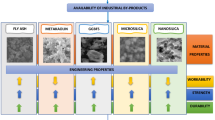Abstract
Global energy consumption has drastically increased over the past years. A huge percentage of this increase tracks back to the buildings and construction industry. A bulk of this energy denotes to providing a suitable indoor environment for the structure. The thermal properties of the structural elements of a building are highly overlooked in the construction industry. Thus, this study aims at shedding light on the possible utilization of the thermal properties of concrete by exploring its thermal behavior upon incorporating three different materials with various dosages without compromising its mechanical behavior. Firstly, blast furnace slag was used to produce and test potentially conductive concrete. Secondly, incorporation of spent coffee grounds is explored in order to improve the insulating properties of concrete, which can contribute to alleviating environmental drawbacks. Moreover, the third material considered was paraffin wax, a phase changing material (PCM), which utilizes thermal energy storage. The work is expected to highlight the utilization of thermal properties of concrete in the construction industry. Furthermore, it shall assess the possible introduction of the aforementioned materials in the construction market for the purpose of producing thermally controlled concrete. The testing scheme targets fresh and hardened concrete properties as well as thermal conductivity. A data logger is used to evaluate the thermal properties of the materials in miniature chambers. Results revealed a good potential for the use of such material in adjusting the thermal properties of the concrete produced. The ultimate goal of this research is to contribute to the assessment of concrete while in service based on its thermal behavior together with its other well-established properties.
Access this chapter
Tax calculation will be finalised at checkout
Purchases are for personal use only
Similar content being viewed by others
References
Asadi I, Shafigh P, Hassan ZFA, Mahyuddin NB (2018) Thermal conductivity of concrete—a review. J Build Eng 20:81–93. https://doi.org/10.1016/j.jobe.2018.07.002
Eliche-Quesada D, Pérez-Villarejo L, Iglesias-Godino FJ, Martínez-García C, Corpas-Iglesias FA (2011) Incorporation of coffee grounds into clay brick production. Adv Appl Ceram 110(4):225–232. https://doi.org/10.1179/1743676111y.0000000006
Evers AC, Medina MA, Fang Y (2010) Evaluation of the thermal performance of frame walls enhanced with paraffin and hydrated salt phase change materials using a dynamic wall simulator. Build Environ 45(8):1762–1768. https://doi.org/10.1016/j.buildenv.2010.02.002
IEA - International Energy Agency (2019) Perspectives for a clean energy transition. The critical role of buildings. Energy Transition Progress and Outlook to 2020
Jelle BP, Gustavsen A, Baetens R (2010) The path to the high performance thermal building insulation materials and solutions of tomorrow. J Build Phys 34(2):99–123. https://doi.org/10.1177/1744259110372782
Kim K-H, Jeon S-E, Kim J-K, Yang S (2003) An experimental study on thermal conductivity of concrete. Cem Concr Res 33(3):363–371. https://doi.org/10.1016/s0008-8846(02)00965-1
Lachheb A, Allouhi A, El Marhoune M, Saadani R, Kousksou T, Jamil A, Rahmoune M, Oussouaddi O (2019) Thermal insulation improvement in construction materials by adding spent coffee grounds: an experimental and simulation study. J Clean Prod 209:1411–1419. https://doi.org/10.1016/j.jclepro.2018.11.140
Ling T-C, Poon C-S (2013) Use of phase change materials for thermal energy storage in concrete: an overview. Constr Build Mater 46:55–62. https://doi.org/10.1016/j.conbuildmat.2013.04.031
Murali G, Mayilsamy K, Arjunan TV (2014) An experimental study of PCM-incorporated thermosyphon solar water heating system. Int J Green Energy 12(9):978–986. https://doi.org/10.1080/15435075.2014.888663
Ostry M, Charvat P (2013) Materials for advanced heat storage in buildings. Procedia Eng 57:837–843. https://doi.org/10.1016/j.proeng.2013.04.106
Šavija B (2018) Smart crack control in concrete through use of phase change materials (PCMs): a review. Materials 11(5):654. https://doi.org/10.3390/ma11050654
Zhou D, Zhao CY, Tian Y (2012) Review on thermal energy storage with phase change materials (PCMs) in building applications. Appl Energy 92:593–605. https://doi.org/10.1016/j.apenergy.2011.08.025
Author information
Authors and Affiliations
Corresponding author
Editor information
Editors and Affiliations
Rights and permissions
Copyright information
© 2023 Canadian Society for Civil Engineering
About this paper
Cite this paper
Badawy, A. et al. (2023). Thermally Controlled Concrete Incorporating Waste Materials and Byproducts. In: Walbridge, S., et al. Proceedings of the Canadian Society of Civil Engineering Annual Conference 2021 . CSCE 2021. Lecture Notes in Civil Engineering, vol 248. Springer, Singapore. https://doi.org/10.1007/978-981-19-1004-3_5
Download citation
DOI: https://doi.org/10.1007/978-981-19-1004-3_5
Published:
Publisher Name: Springer, Singapore
Print ISBN: 978-981-19-1003-6
Online ISBN: 978-981-19-1004-3
eBook Packages: EngineeringEngineering (R0)




